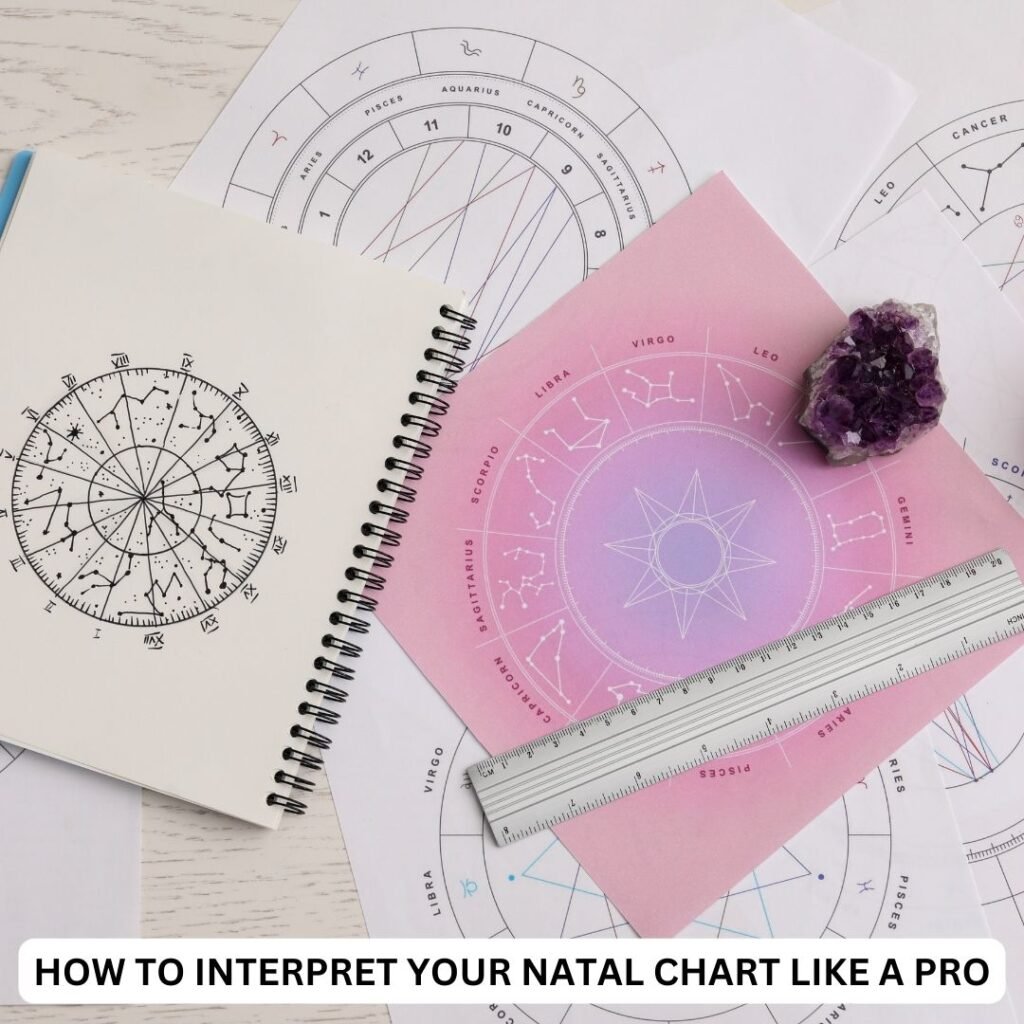
INTERPRET YOUR NATAL CHART
Interpreting a natal chart can be both an enlightening and daunting task. It’s a detailed map of the sky at the moment of your birth, reflecting the positions of planets and their potential influences on your personality, relationships, career, and more. Here’s a step-by-step guide to help you understand and interpret your natal chart like a pro.
Understanding the Basics
What is a Natal Chart?
A natal chart, also known as a birth chart, is a snapshot of the sky at the exact moment you were born. It’s based on your birth date, time, and place. The chart is divided into twelve houses, each representing different areas of life, and it shows the positions of the planets in these houses and zodiac signs.
Key Components of a Natal Chart
Ascendant (Rising Sign): This is the sign on the horizon at the time of your birth. It represents your outward personality and how others perceive you.
Sun Sign: This is the position of the sun in the zodiac at your birth. It represents your core identity and ego.
Moon Sign: This is the position of the moon in the zodiac. It represents your emotions, instincts, and subconscious mind.
Planets: Each planet represents different aspects of your personality and life:
- Mercury: Communication and intellect.
- Venus: Love and beauty.
- Mars: Action and desire.
- Jupiter: Growth and abundance.
- Saturn: Discipline and challenges.
- Uranus: Innovation and rebellion.
- Neptune: Dreams and intuition.
- Pluto: Transformation and power.
Houses: There are twelve houses, each associated with different life areas:
- 1st House: Self and appearance.
- 2nd House: Values and possessions.
- 3rd House: Communication and siblings.
- 4th House: Home and family.
- 5th House: Creativity and children.
- 6th House: Health and work.
- 7th House: Partnerships and marriage.
- 8th House: Transformation and shared resources.
- 9th House: Philosophy and travel.
- 10th House: Career and public life.
- 11th House: Friends and social causes.
- 12th House: Subconscious and spirituality.5

Step-by-Step Guide to Interpreting Your Natal Chart
Step 1: Identify Your Ascendant
The ascendant, or rising sign, is crucial as it influences your appearance and the first impression you make on others. It also determines the layout of your houses. To find your ascendant, you need your exact birth time and location. Many online calculators can help you find this information.
Step 2: Locate Your Sun and Moon Signs
Your sun sign represents your core essence and ego, while your moon sign reveals your inner emotions and subconscious. These two signs are fundamental in understanding your primary motivations and emotional responses.
Step 3: Examine Planetary Placements
Look at where each planet falls in your chart. Each planet’s position in a sign and house provides insights into different areas of your life:
- Personal Planets (Sun, Moon, Mercury, Venus, Mars): These reflect your personality and day-to-day experiences.
- Social Planets (Jupiter and Saturn): These show your interaction with society and long-term goals.
- Transpersonal Planets (Uranus, Neptune, Pluto): These influence your deeper life transformations and spiritual evolution.
Step 4: Analyze Aspects
Aspects are angles formed between planets. They can be harmonious (trines and sextiles) or challenging (squares and oppositions). Understanding aspects helps you see how different parts of your personality interact:
- Conjunction (0°): Planets are close together, blending their energies.
- Sextile (60°) and Trine (120°): Positive and harmonious relationships.
- Square (90°) and Opposition (180°): Tension and challenges that drive growth.
Step 5: Interpret Each House
Each house in your natal chart governs different life areas. By examining which planets reside in which houses, you can gain deeper insights into various aspects of your life:
- 1st House: Identity and self-expression.
- 2nd House: Finances and values.
- 3rd House: Communication and learning.
- 4th House: Home and family roots.
- 5th House: Creativity and pleasure.
- 6th House: Work and health.
- 7th House: Partnerships and marriage.
- 8th House: Transformation and shared resources.
- 9th House: Philosophy and higher learning.
- 10th House: Career and public life.
- 11th House: Friendships and community.
- 12th House: Spirituality and subconscious.
Step 6: Synthesize the Information
Interpreting a natal chart is like putting together a puzzle. You need to synthesize all the information to form a cohesive understanding of your personality and life path. Here’s how:
- Start with the Big Three: Ascendant, Sun, and Moon. These give you a broad understanding of your outer self, core identity, and inner emotions.
- Consider the Elements and Modalities: Each sign is associated with an element (fire, earth, air, water) and a modality (cardinal, fixed, mutable). These add layers to your understanding of how you interact with the world.
- Look at Planetary Placements and Aspects: Identify key themes and patterns. For example, if you have many planets in fire signs, you might be passionate and dynamic. If you have many challenging aspects, you might face significant obstacles that lead to growth.
- Integrate the Houses: See how different life areas are influenced by the planets. For instance, if you have Venus in the 7th house, relationships might play a significant role in your life.
Practical Tips for Pro-Level Interpretation
- Take Notes: Write down key points about each component of your chart. This will help you see connections and themes more clearly.
- Use Reliable Resources: Books, reputable websites, and professional astrologers can provide deeper insights and validation.
- Practice on Multiple Charts: The more charts you interpret, the more proficient you’ll become. Compare charts of friends, family, and famous people to see how planetary placements manifest in different lives.
- Stay Open-Minded: Astrology is both an art and a science. While technical knowledge is crucial, intuition and personal experience play a significant role in interpretation.
Conclusion
Interpreting a natal chart is a journey of self-discovery. It offers a profound understanding of your strengths, challenges, and life purpose. By following this guide and practicing regularly, you can become proficient in reading and interpreting natal charts, unveiling the celestial map that guides your unique life path.
